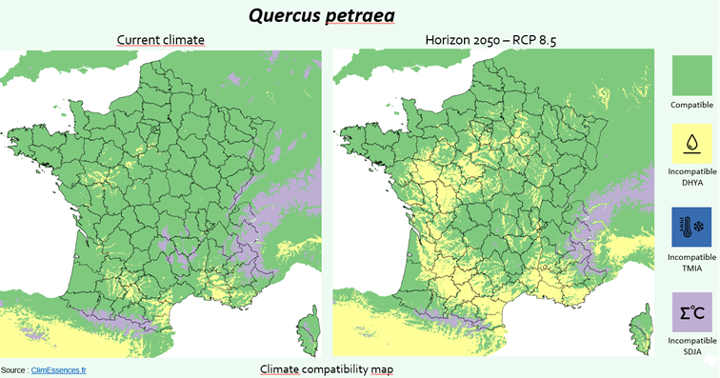The concept of assisted migration is based on choosing species and provenances that have grown for generations in contexts that are more restrictive from a hydric and temperature point of view than the target forest areas the MigFoRest project team have identified in North-West Europe (NWE). It is generally accepted that southern and/or Mediterranean species and provenances fall into this category. However, when selecting provenances, notably based on both climatic and geological characteristics of the stands where seeds and seedlings will come from, it is needed to rely on objective criteria.
To back the selection process, ClimEssences is used. ClimEssences is a tool developed in France by the Aforce network, designed to assess and visualize the impact of climate change on forest ecosystems. It provides detailed information about climate variables and on how they will affect the compatibility of a species to a given area in different climatic scenarios.
Three climate variables are chosen to maximize the likelihood of the “migrated” trees to adapt to more Northern climate, which are:
![]()
1. The annual water deficit (DHYa in the ClimEssences terminology) of the stands.
This is the annual accumulation of the monthly water deficits calculated by making a cumulative monthly balance of precipitation minus potential evapotranspiration (ETP), considering the maximum useful soil reserve and, in simplified terms, whether the precipitation is in the form of snow or not. Key factors for calculating DHYa include:
- Monthly minimum and maximum, and average temperatures
- Monthly precipitation
- Maximum useful soil reserve
- Latitude of the site
To minimize bias from initial conditions, calculations are averaged over three years, retaining only the final year’s data.
![]()
2. The minimum annual temperature (TMIA) which, below a minimum threshold, corresponds to the limiting factor of excess cold.
![]()
3. The sum of annual Degree Days (SDJA) which is the sum of daily average temperatures where the average temperature is above 5°C. When below a minimum threshold, it corresponds to the limiting factor lack of heat.
Then, those 3 variables are integrated into a selection method based on the so-called IKS model, created by forestry expert Hervé Le Bouler (see graph below), by crossing the map of current climate data and current availability of a given species in Europe (based on the European national forest inventories).
Thresholds on the three climate variables are calculated to have a view on the current eligible stands.
Secondly, the same thresholds are applied on a given species based on anticipated future climate data. This enables to generate a map of the future species compatibility with the NWE climate criteria.
Here is an example of a mapping of compatible stands for the sessile oak (Quercus petraea) now and in 2050 in France.

Ultimately, the outcome of this cartography is crossed with the FOREMATIS database on forest reproductive material to have a more precise view on the eligible stands.
You will be kept informed on the use of that method and the first actual provenances selected, by tree species.